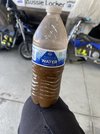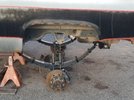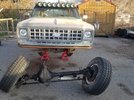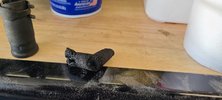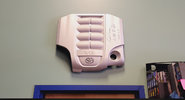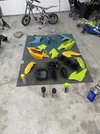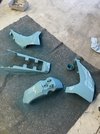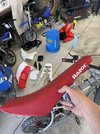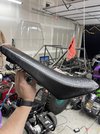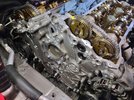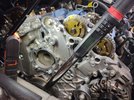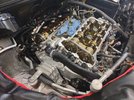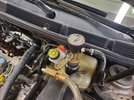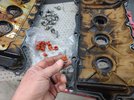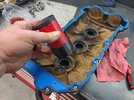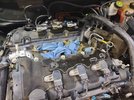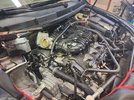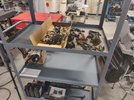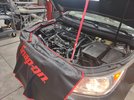I've had a Buick LaCrosse with the High Feature V6 in the shop the last week. The owner brought it to me with an oil leak a month or so ago to see if I could identity where it was coming from. Unfortunately, it was coming from the right bank at the union of the head and front timing cover.
I explained that these GM High Features V6's are a good engine but they have one area that needs to be addressed around the 120k-140k range if they are well cared for and that is the timing chains, guides and tensioners. If neglected these can have a catastrophic failure much sooner, as I had one fail for a gentleman around 80k because he insisted on extended oil service intervals. The worse things on any of these modern engines that utilize VVT configurations is extended oil change intervals. Fresh, clean and healthy oil is a must for any of these modern engines to survive as the oil serves not only for lubricity and cooling but also as hydraulics for the many phasers and tensioners in the VVT systems.
This car was the perfect candidate as the owners are adamant about oil changes and take very good care of the car. I gave a quote and laid out the options as far as some preventive maintenance on the timing chains system and fixing the leak vs. looking for something else and gave them time to discuss. They had discussed it and called me back a week or so later to approve the repairs so I ordered the parts and put the car in line on the "list" of to-do items.
This really isn't a difficult job but one that needs to have attention paid to it as there are a lot of moving parts and the timing system has three timing chains, two idlers, three hydraulic tensioners and 6 guides all of which must go together in the proper order and timing. This engine has two timing stages, Stage 1 is the left bank secondary chain and primary chain and then the engine must be put into Stage 2 for the right bank secondary chain and related components. Also the front timing cover is cast aluminum and care must be taken to ensure a leak free repair as it's going back together. Ideally this job is much easier with the engine/trans and cradle assembly lowered from the car but it can be done with everything in the car, it's just a bit more problematic due to space constraints and access.
Car racked and ready to begin the repair. This really is a nice clean car for 130k miles and 13 years old now.
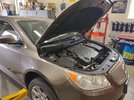
Teardown commenced.
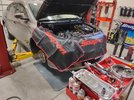
Upper intake plenum removed, rocker covers removed, wiring loom laid out of the way, upper motor mount assembly along with accessory drive and belt removed and finally the timing cover removed gaining access to the timing chain and related components. The majority of the work and time is just getting to the timing chains, replacing them is relatively easy and quick. Luckily we caught this engine in time as the chains were showing signs of severe stretch but not quite to the point of jumping timing yet or even getting some of the common diagnostic codes that go along with this system displaying camshaft correlation codes. Down near the bottom left of the picture you can see the power steering pump which was actually the worst part of this job as the fasteners need to be removed so it can be pushed out of the way only about 1/2"-3/4" just to allow access to two timing cover bolts.

All timing chains, guides, tensioners, idlers and sprockets removed so cleaning of the block and heads sealing surfaces can be cleaned. I highly recommend a plastic razor blade followed by carbon gasket scrapers and lastly a chase with Scotchbrite to clean the surface as anything more aggressive can gouge the aluminum and create a potential leak point. The block, head and oil pan have smooth machined surfaces for sealing.
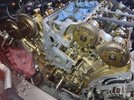
All new parts at the ready in preparation for installation. I also soak the chains in oil the night before so they don't get damaged from dry starting until oil can begin flowing/slinging.
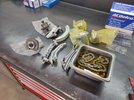
Timing cover is thoroughly cleaned inside and out along with new VVT solenoid valve seals, crankshaft seal and water pump seal. IF you look closely near the grooves machined in the sealing surface you can see a coarser crosshatch pattern. The sealant is to be applied into the grooved so ensure the grooves are properly cleaned of old sealant but the coarse crosshatch machining pattern in the sealing surface it so actually hold and retain a certain amount of sealant to allow proper sealing of the engine.
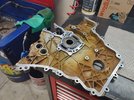
I probably spend a bit more time cleaning parts than many shops but I can't seem to put filthy parts back together on a job. The lower timing cover was oil soaked and required some heavy scrubbing with a toothbrush and solvent brush in the solvent tank. Here you can see all the new seals installed and the cover awaiting installation.
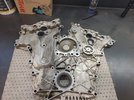
The engine is in Stage 1 timing. This can be a bit confusing as Stage 1 timing is actually starting with assembly of Bank 2 (left bank). Bank 1 on this engine is the right bank which is up against the firewall. With the engine in Stage 1, the camshaft flats must be horizontal and the timing marks on the phasers properly lined up as well as the crankshaft at Stage 1 with the crank timing mark at about the 5 o'clock position on the oil pump. There are exactly ten links between the timing marks on the phasers so that is another way to ensure the cams haven't slipped out of time with one another. Also worth noting is as soon as the rocker covers and timing covers are off you should do a quick check of the phasers to ensure they are not damaged. They should lock in the static position so if there is any movement of the camshaft separately from the phasers in the static condition now would be the time to replace the affected phaser(s). Guides in place, tensioners in place, idler in place and all torqued to proper spec before even thinking about rolling the engine over into Stage 2 timing.
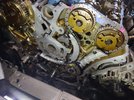
With everything double checked the engine can be rolled over to Stage 2 timing with the crankshaft sprocket aligning with the timing mark around the 8 o'clock position on the oil pump. Now the seconday timing chain and related components can be installed on Bank 1 (rear against firewall on this engine).
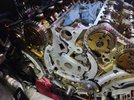
With the timing system completed a final wipe of the sealing surface on the block, heads and oil pan with a lint free rag and brake wash in preparation to receive the timing cover and sealant. The sealant is applied to the timing cover. The FSM states a 3mm (~1/8") around the perimeter of the timing cover with the exception of the areas where components such as heads and block meet and it specified in those area a 5mm (~13/64") bead be applied. My sealant of choice for the past couple of decades now has been the GM ES (Engine Sealant) as I feel it is the perfect balance of adhesive and sealing materials. I also applied a very thin application of Sil-Glyde to the rubber seals to aid in assembly without damaging the rubber sealing surfaces. Guess this is habit more than anything. I must stress the importance of not using any mechanized means of removing the old sealant from these surfaces as they are precisely machined to not only have the crosshatch pattern but also the distance between the block and standoffs cast into the timing cover must be exact or improper sealing could occur.
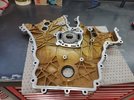
More pics to follow.....

 www.instagram.com
www.instagram.com
